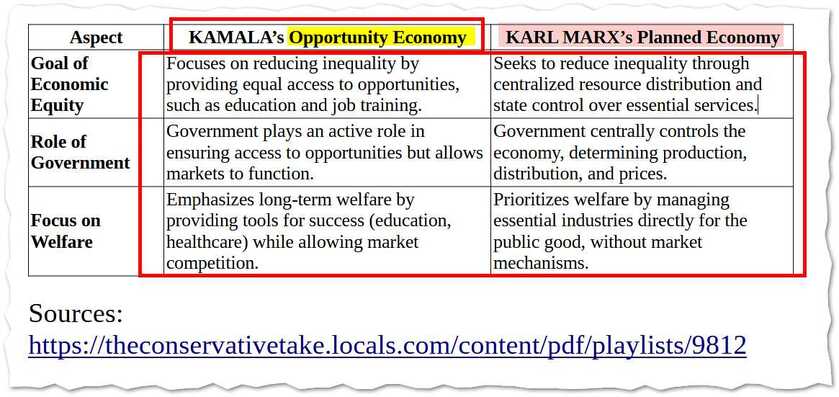In today’s political discourse, the concept of the "opportunity economy" has been gaining momentum. It suggests a vision where the government actively ensures that everyone has access to the resources needed to succeed—be it through education, healthcare, or economic support. While it sounds progressive and inclusive, there are clear parallels between this system and Karl Marx’s "planned economy," where the state plays a central role in distributing resources and controlling production.
Let's break down the key similarities between Kamala Harris’s opportunity economy and Marx’s planned economy to understand why both systems, at their core, reflect Marxist principles where the government is the central driver of the economy.
Table: Similarities Between Opportunity Economy and Planned Economy
| Aspect | Opportunity Economy | Planned Economy |
|---|---|---|
| Goal of Economic Equity | Focuses on reducing inequality by providing equal access to opportunities (education, healthcare, etc.). | Seeks to reduce inequality through centralized resource distribution and state control. |
| Role of Government | Government plays an active role in ensuring access to resources but allows market participation. | Government centrally controls all economic activity, including production and distribution. |
| Focus on Welfare | Emphasizes welfare by providing tools (education, healthcare) within a free market system. | Prioritizes welfare by directly controlling key sectors for public good. |
1. Goal of Economic Equity
In Kamala’s opportunity economy, the government aims to level the playing field by ensuring equal access to resources, especially in areas like healthcare, education, and jobs. Programs like student loan forgiveness and government-funded training initiatives are examples of how the state intervenes to promote equity.
Similarly, Marx’s planned economy focuses on the redistribution of wealth and resources to eliminate class disparities. In this model, the state owns and controls the means of production, ensuring that all citizens have equal access to essential goods and services.
Conclusion: Both systems claim to create an equitable society, but their reliance on heavy government intervention to enforce fairness is fundamentally flawed. Over-centralization of economic control often leads to inefficiency, bureaucratic stagnation, and limits on individual freedoms. The excessive regulation and redistribution of resources can undermine personal responsibility, stifle innovation, and reduce incentives for productivity, all of which are critical for long-term economic growth. Moreover, such government-heavy approaches risk creating dependency on state programs, ultimately weakening the very economic foundations they seek to improve.
2. Role of Government
In an opportunity economy, the government’s role is robust. Harris and similar proponents advocate for policies where the state provides the infrastructure for success, such as affordable healthcare and universal pre-K. While private enterprise still exists, the government directs key sectors that affect the public good.
Marx’s planned economy takes this a step further. The state doesn’t just influence but controls all aspects of the economy—from production to distribution. Private ownership is minimized, and the government dictates prices, wages, and outputs.
Conclusion: While the opportunity economy allows for private enterprise within certain constraints, framing the government as the ultimate authority in shaping economic outcomes is inherently flawed. By centralizing control, it risks undermining the efficiency, innovation, and competition that private markets foster. Heavy government intervention can distort market signals, leading to inefficient allocation of resources and stifling entrepreneurship. This excessive reliance on government authority may also create bureaucratic inefficiencies and reduce individuals' incentives to take economic risks, ultimately hampering economic growth and dynamism.
3. Focus on Welfare
Both systems place heavy emphasis on welfare. In Harris's opportunity economy, the government uses tax dollars to fund safety nets like universal healthcare and affordable housing, ensuring that every citizen has a basic foundation for success. However, these programs are largely funded by taxpayer contributions, which can lead to higher taxes, particularly on businesses and higher-income individuals. This system may unintentionally disincentivize work by reducing the motivation to pursue higher wages, as individuals might receive substantial government support regardless of their employment status. Critics argue that this could lead to dependency on government aid, reducing the incentive for personal economic advancement, a common criticism of welfare-heavy models
In a planned economy, welfare is a central goal. The government’s control of production ensures that all citizens receive their share of resources, which is distributed based on need. By eliminating market-driven inequalities, the state guarantees that basic human needs are met for everyone.
Conclusion: Both systems claim to prioritize citizens' well-being but rely on flawed mechanisms. In the opportunity economy, welfare is embedded in regulations that control key sectors like healthcare and education, funded by taxpayer dollars. However, these policies often lead to inefficiencies and burdens on the economy, as higher taxes can stifle innovation and personal ambition. On the other hand, in a planned economy, the government directly provides these services, but this centralization can result in bureaucratic inefficiencies and lack of responsiveness to individual needs. Both systems, while aiming for equality, often fail to achieve their goals effectively, leading to economic stagnation and dependency.
Both Systems Are Rooted in Marxist Principles
Though the opportunity economy doesn’t fully embrace Marxist principles of abolishing private property, it certainly leans towards them by positioning the government as the primary driver of economic equity. Harris’s vision of an economy where the government ensures equal access to resources is a modern adaptation of Marxist thought. The planned economy pushes this idea further by placing complete control of the economy in the hands of the state.
In both cases, the government's role as the central force for ensuring "fairness" and redistributing resources for the so-called "public good" is deeply flawed and dangerous. These approaches undermine individual liberty by limiting market forces, placing economic control in the hands of the state, and dismissing the importance of personal responsibility and free enterprise. This concentration of power goes against the principles of a constitutional republic founded on the belief that rights come from God, not the state. The Founding Fathers of the United States envisioned a system of limited government, where individual rights and freedoms were protected from government overreach. By shifting control to the state, both systems risk eroding personal freedoms and establishing a dependence on government—a stark contrast to the ideals of self-reliance, private property, and free markets that were central to the founding of the nation. Such centralization of power paves the way for tyranny and weakens the fundamental principles that safeguard individual liberty
Sources:
https://theconservativetake.locals.com/content/pdf/playlists/9812














